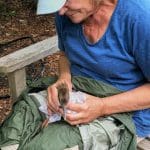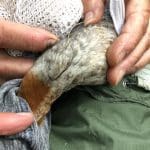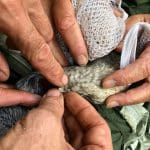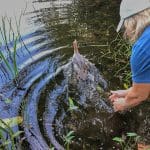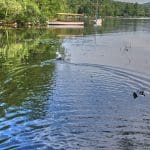10
Sep
Merganser Update
With help from a dedicated wildlife biologist, John Cooley, senior biologist at Loon Preservation Committee, we were able to locate, catch and remove the hook and leader from the young merganser on Friday 9/7. It was a wet, muddy, but truly lucky day. First, the family was in a shallow cove along Lakeshore Drive, providing easy access and a place to corner them. Second, after herding them slowly to the back of the cove we waded through the muck and maneuvered them into a culvert under a driveway without having to try to catch them. We blocked off the entrances to the culvert with nets and tried to isolate the “hooked” chick. The third bit of luck was that our target chick was the first to exit the culvert into Jen’s waiting net. As soon as the chick was freed from the net and in Jen’s hands it calmed down.
We confirmed that the hook was only superficially embedded and there was no sign of infection. The biologist cut the hook shaft and worked out the embedded tip. Our patient was perky and calm following that. After John Cooley checked where the hook had been for any signs of damage or infection, Jen carried the chick to the water and let it free.
We watched it swim away calling to its family and were delighted to see them all come together at the entrance to the cove. Our muddy and happy trio worked our way back to our boats and as we left the cove, we could see the whole family swimming and diving on the lake. A wonderfully satisfying end to our lucky day.
Not every hooked bird is so lucky. Please be careful with your fishing gear and consider using barbless hooks – especially if you are not planning to keep what you catch. Our loons and mergansers are vital to the health of the fish populations in the lake!
Many thanks to John Cooley, senior biologist at Loon Preservation Committee (LPC), for giving up 3 hours of his personal time on Friday afternoon to help us rescue our little Merganser chick.
LPC provides the Sunapee region, including Pleasant Lake, with a field biologist every summer who checks on our loons and tests the egg shell fragments for Mercury and other pollutants that may be affecting our Lake and other wildlife. They have banded some of our Loons including our adult male in 2010. Our female was originally banded on Squam Lake in 2001 and re-banded on Pleasant Lake in 2010.
Below is a link to the LPC website for more information on them and what they do. We couldn’t have done this without their help!

